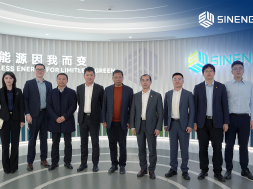
SCIENTISTS HAVE CREATED INVISIBLE SOLAR PANELS WHICH LOOK LIKE WINDOWS
Scientists have created the first fully transparent solar panel in the hope that it may lead to a wider rollout of solar energy usage in domestic settings.
Solar panels are currently opaque, which means they can only be used on solar farms and on roofs. Now scientists at Incheon University in South Korea have managed to put their theory into practice by creating a new, transparent version.
This is the first time a fully clear solar cell has been attempted. Normally, the semiconductor layers, which catch the light and turn it into electricity, are the reason for their opaque colour.
Researchers at Incheon University have replaced these layers with Titanium Dioxide and Nickel Oxide instead. Both materials have high optical transparency, so have the capacity to let through plenty of visible light.
However, the efficiency rate of the transparent solar panel is only at 2 per cent at the moment.
We spoke to solar expert Dr Stuart Irvine, Director of the Centre for Solar Energy Research at Swansea University, about the complications this may pose.
For Irvine, a low rate of efficiency is “the biggest challenge” for a wider rollout.
“The challenge here is, how far can they push the efficiency to actually get a useful amount of electricity out?” he says.
The work completed by the university in South Korea adds to other research being done globally to see how solar energy can be integrated into buildings. Dr Irvine calls the ongoing research “exciting”.
Asia is no stranger to solar development, with scientists at the Solar Energy Research Institute of Singapore previously producing double-sided panels which were found to be 35 per cent more effective.
EUROPEANS SUPPORT SOLAR
Solar panels have become increasingly popular as a source of renewable energy in Europe, with the highest support hailing from Italy, France and Germany.
In Germany, there was a 25 per cent increase of solar panel installations in 2020, in comparison to the previous year.
Overall, 19.7 per cent of energy consumed in the EU in 2019 was from renewable energy, with Sweden racing ahead with nearly 60 per cent. Belgium came in last with only 10 per cent of the country’s energy produced by sustainable sources.
Despite the low energy efficiency of the transparent solar panels, Dr Irvine does not rule out the potential it may have for mobile phones and smaller domestic products.
“With consumer products, I think there is huge potential, and it doesn’t need a lot of power,” he says, acknowledging that solar energy will probably be used in new markets and in new ways that have not been thought of in the future.















